What We’re Reading: Sept 7th
Review: Harnessing synthetic chemistry to probe and hijack auxin signaling
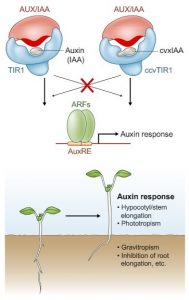 Auxin has been studied since Charles Darwin observed the phototropic response. More recently, chemical genetic approaches using auxin agonists and antagonists have been applied to studies of auxin. Torii et al. review how synthetic chemistry and chemical genetics have provided insights into and new tools for controlling auxin signaling. The authors briefly discuss synthetic auxins and auxinic herbicides (1-NAA, 2,4-D, 2,4,5-T, MCPB, picloram, triclopyr, dicamba, tricamba), as well as auxin antagonists (BH-IAA, PEO-IAA, auxinole). They also describe the recently published “bump and hole” approach, where auxin responses are controlled by the interaction between the inactive auxin analog, cvxIAA, which is recognized only by the engineered TIR1 receptor, ccvTIR1. In ccvTIR1, the 79th phenylalanine residue of TIR1 has been replaced with a glycine residue, rendering ccvTIR1 insensitive to the endogenous and synthetic auxins IAA, 1-NAA and 2,4-D. The synthesized auxin analog cvxIAA [5-(3-methylphenoxyl-IAA)] has reduced affinity for the natural receptor TIR1 and high affinity for the engineered receptor ccvTIR1. Overall, this review focuses on the powerful future application of engineered auxin receptors that can provide tissue-specific auxin responses to better understand auxin-mediated development. (Summary by Arif Ashraf) New Phytol. 10.1111/nph.15337
Auxin has been studied since Charles Darwin observed the phototropic response. More recently, chemical genetic approaches using auxin agonists and antagonists have been applied to studies of auxin. Torii et al. review how synthetic chemistry and chemical genetics have provided insights into and new tools for controlling auxin signaling. The authors briefly discuss synthetic auxins and auxinic herbicides (1-NAA, 2,4-D, 2,4,5-T, MCPB, picloram, triclopyr, dicamba, tricamba), as well as auxin antagonists (BH-IAA, PEO-IAA, auxinole). They also describe the recently published “bump and hole” approach, where auxin responses are controlled by the interaction between the inactive auxin analog, cvxIAA, which is recognized only by the engineered TIR1 receptor, ccvTIR1. In ccvTIR1, the 79th phenylalanine residue of TIR1 has been replaced with a glycine residue, rendering ccvTIR1 insensitive to the endogenous and synthetic auxins IAA, 1-NAA and 2,4-D. The synthesized auxin analog cvxIAA [5-(3-methylphenoxyl-IAA)] has reduced affinity for the natural receptor TIR1 and high affinity for the engineered receptor ccvTIR1. Overall, this review focuses on the powerful future application of engineered auxin receptors that can provide tissue-specific auxin responses to better understand auxin-mediated development. (Summary by Arif Ashraf) New Phytol. 10.1111/nph.15337
Survival of the kleptoplasts
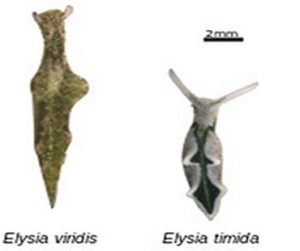 How chloroplasts remain viable inside of herbivorous sea slugs is a long-standing curiosity. Unlike corals, which host intact photosynthetic algae, sea slugs retain naked chloroplasts (which are then called kleptoplasts – stolen plastids), some of which remain viable for seveal weeks. Christa et al. explored how kleptoplasts from diverse algal species survive without the support of a photosynthetic nucleus. The authors investigated the possibility that some kleptoplasts retain the ability to replace photodamaged D1 protein of photosystem II, due to the presence of a plastid-encoded FTSH protease involved in this process. However, the authors determined that the plastid-encoded protein from most sea slug algal food sources lacks a crucial FTSH domain needed for this repair mechanism, that D1 protein replacement is not the basis for kleptoplast longevity in most species, and that many questions remain unanswered about this intriguing system. (Summary by Mary Williams) Frontiers Ecol. Evol. 10.3389/fevo.2018.00121
How chloroplasts remain viable inside of herbivorous sea slugs is a long-standing curiosity. Unlike corals, which host intact photosynthetic algae, sea slugs retain naked chloroplasts (which are then called kleptoplasts – stolen plastids), some of which remain viable for seveal weeks. Christa et al. explored how kleptoplasts from diverse algal species survive without the support of a photosynthetic nucleus. The authors investigated the possibility that some kleptoplasts retain the ability to replace photodamaged D1 protein of photosystem II, due to the presence of a plastid-encoded FTSH protease involved in this process. However, the authors determined that the plastid-encoded protein from most sea slug algal food sources lacks a crucial FTSH domain needed for this repair mechanism, that D1 protein replacement is not the basis for kleptoplast longevity in most species, and that many questions remain unanswered about this intriguing system. (Summary by Mary Williams) Frontiers Ecol. Evol. 10.3389/fevo.2018.00121
Viral sequences in the Arabidopsis genome ($)
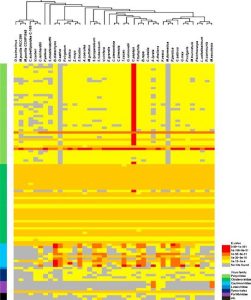 Numerous prokaryotic and eukaryotic genes have been identified as having homology to viral sequences. This phenomenon is the result of horizontal gene transfer (HGT) between viral pathogens and host cells. Chu and collaborators performed a proteome-wide analysis for the identification of viral domains in the Arabidopsis proteome. The study identified 101 plant viral peptide sequences that matched at least one Arabidopsis protein, and hundreds of Arabidopsis proteins predicted to be homologous to viral proteins. From the latter, the most abundant corresponded to heat shock 70 domains and RNA helicase proteins. The taxonomical classification of the 101 viral proteins resulted in the vast majority of the studied sequences attributed to ssRNA viruses, followed by dsDNA and dsRNA viruses. Interestingly, the distribution of viral-derived sequences in the Arabidopsis genome did not appear to be random, and several of these viral-like proteins were found in many other plant genomes, indicating the high evolutionary conservancy and specificity of HGT phenomena between viruses and plants. (Summary by Juan S. Ramirez-Prado) Mol. Phylogenetics Evol. 10.1016/j.ympev.2018.08.009
Numerous prokaryotic and eukaryotic genes have been identified as having homology to viral sequences. This phenomenon is the result of horizontal gene transfer (HGT) between viral pathogens and host cells. Chu and collaborators performed a proteome-wide analysis for the identification of viral domains in the Arabidopsis proteome. The study identified 101 plant viral peptide sequences that matched at least one Arabidopsis protein, and hundreds of Arabidopsis proteins predicted to be homologous to viral proteins. From the latter, the most abundant corresponded to heat shock 70 domains and RNA helicase proteins. The taxonomical classification of the 101 viral proteins resulted in the vast majority of the studied sequences attributed to ssRNA viruses, followed by dsDNA and dsRNA viruses. Interestingly, the distribution of viral-derived sequences in the Arabidopsis genome did not appear to be random, and several of these viral-like proteins were found in many other plant genomes, indicating the high evolutionary conservancy and specificity of HGT phenomena between viruses and plants. (Summary by Juan S. Ramirez-Prado) Mol. Phylogenetics Evol. 10.1016/j.ympev.2018.08.009
Importance of SNARE proteins in the replication vesicle trafficking of turnip mosaic virus ($)
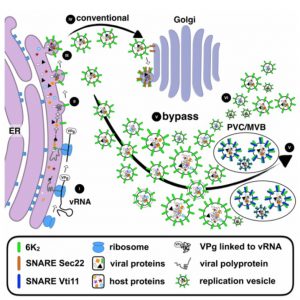 When plant cells are infected by RNA viruses, viral replication complexes are generated in organelle-like structures. These vesicles are important for the replication of viral RNA (vRNA) as well as moving vRNA-protein complexes through plasmodesmata to infect other plant cells. When turnip mosaic virus (TuMV) infects Nicotiana benthamiana, the viral membrane protein 6K2 has an important role in the release of these replication vesicles from the plant endoplasmic reticulum. This paper elucidates the role of the proteins 6K2, Sec22 and VTI11 in TuMV infection using protein studies, plant infection studies and microscopy. 6K2 contains a GxxxG motif that is essential for TuMV infection. If the motif is mutated, the viral protein is mislocated to the Golgi apparatus and the plasma membrane. Using co-immunoprecipitation, 6K2 co-purified with Sec22, a SNARE, and VTI11, a pre-vacuolar compartment SNARE. Overexpression of Sec22 in Nicotiana benthamiana resulted in increased intercellular movement of TuMV. Additionally, an Arabidopsis thaliana vti11 mutant was resistant to TuMV infection. These results indicate the TuMV replication vesicles use an unconventional pathway that does not include the Golgi apparatus, but may include pre-vacuolar compartments or multivesicular bodies. (Summary by Julia Miller) Plant Cell 10.1105/tpc.18.00281
When plant cells are infected by RNA viruses, viral replication complexes are generated in organelle-like structures. These vesicles are important for the replication of viral RNA (vRNA) as well as moving vRNA-protein complexes through plasmodesmata to infect other plant cells. When turnip mosaic virus (TuMV) infects Nicotiana benthamiana, the viral membrane protein 6K2 has an important role in the release of these replication vesicles from the plant endoplasmic reticulum. This paper elucidates the role of the proteins 6K2, Sec22 and VTI11 in TuMV infection using protein studies, plant infection studies and microscopy. 6K2 contains a GxxxG motif that is essential for TuMV infection. If the motif is mutated, the viral protein is mislocated to the Golgi apparatus and the plasma membrane. Using co-immunoprecipitation, 6K2 co-purified with Sec22, a SNARE, and VTI11, a pre-vacuolar compartment SNARE. Overexpression of Sec22 in Nicotiana benthamiana resulted in increased intercellular movement of TuMV. Additionally, an Arabidopsis thaliana vti11 mutant was resistant to TuMV infection. These results indicate the TuMV replication vesicles use an unconventional pathway that does not include the Golgi apparatus, but may include pre-vacuolar compartments or multivesicular bodies. (Summary by Julia Miller) Plant Cell 10.1105/tpc.18.00281
Arabidopsis Formin 2 regulates cell-to-cell trafficking through plasmodesmata
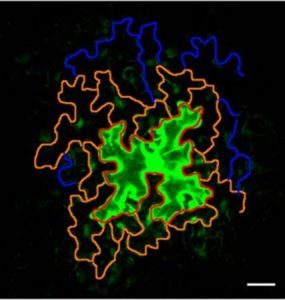 Plasmodesmata are cell-cell junctions that form cytosolic channels between neighboring plant cells. These junctions mediate the exchange of information between cells during various stress and developmental programs by actively regulating the aperture of the channel entrance or ‘pore’. In a new study published in eLIFE, Diao et al. discovered that the Arabidopsis actin nucleation factor Formin 2 (AtFH2) localizes to plasmodesmata and regulates cell-cell trafficking. The authors show that basal plasmodesmatal pore size/aperture is increased in atfh2 mutants relative to wild-type plants, leading to susceptibility to plant virus infections that rely on plasmodesmatal channels to cause disease. Further biochemical studies demonstrated that AtFH2 binds and caps actin filaments rather than acting as an actin nucleator in vitro. Together, these data support the idea that AtFH2 stabilizes and anchors actin filaments at plasmodesmata to regulate cell-to-cell trafficking in plants. (Summary by Phil Carella) eLIFE 10.7554/eLife.36316
Plasmodesmata are cell-cell junctions that form cytosolic channels between neighboring plant cells. These junctions mediate the exchange of information between cells during various stress and developmental programs by actively regulating the aperture of the channel entrance or ‘pore’. In a new study published in eLIFE, Diao et al. discovered that the Arabidopsis actin nucleation factor Formin 2 (AtFH2) localizes to plasmodesmata and regulates cell-cell trafficking. The authors show that basal plasmodesmatal pore size/aperture is increased in atfh2 mutants relative to wild-type plants, leading to susceptibility to plant virus infections that rely on plasmodesmatal channels to cause disease. Further biochemical studies demonstrated that AtFH2 binds and caps actin filaments rather than acting as an actin nucleator in vitro. Together, these data support the idea that AtFH2 stabilizes and anchors actin filaments at plasmodesmata to regulate cell-to-cell trafficking in plants. (Summary by Phil Carella) eLIFE 10.7554/eLife.36316
Predicting division planes of three-dimensional cells by soap-film minimization ($)
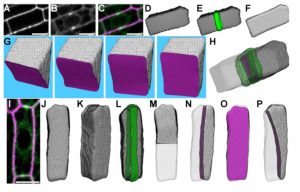 Martinez et al. used a modelling approach to see if it is possible to predict the location of a cell’s future division plane. In most cases the cell divides according to strict geometric rules, such that the newly formed wall will have a minimum area (described as a soap-film minimization model). However, in some cases the predicted plane of division would cause the new cell wall to form in contact with another cell wall junction, which would form a weak, four-way junction. In these cases, the cells regularly selected a different location for the new cell wall; by imaging the position of the pre-prophase band, the authors were able to observe the change in orientation of the future division plane. These studies reveal that the soap-film minimization method is useful for modelling 3D cell division planes, and also that there is communication between existing cell walls and the nascent division plane. (Summary by Mary Williams) Plant Cell 10.1105/tpc.18.00401
Martinez et al. used a modelling approach to see if it is possible to predict the location of a cell’s future division plane. In most cases the cell divides according to strict geometric rules, such that the newly formed wall will have a minimum area (described as a soap-film minimization model). However, in some cases the predicted plane of division would cause the new cell wall to form in contact with another cell wall junction, which would form a weak, four-way junction. In these cases, the cells regularly selected a different location for the new cell wall; by imaging the position of the pre-prophase band, the authors were able to observe the change in orientation of the future division plane. These studies reveal that the soap-film minimization method is useful for modelling 3D cell division planes, and also that there is communication between existing cell walls and the nascent division plane. (Summary by Mary Williams) Plant Cell 10.1105/tpc.18.00401
Ploidy and size at multiple scales in the Arabidopsis sepal
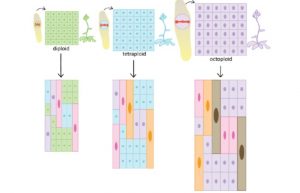 Ploidy refers to the number of genomes contained within a nucleus. Ploidy levels can increase through whole-genome duplication, which affects every cell equally, and through endoreduplication, a cell-by-cell process in which DNA synthesis is not accompanied by cytokinesis. Robinson et al. investigated how increasing ploidy (both types) affects nuclear, cell and organ size. They found that there is a general increase in nuclear size that accompanies increasing ploidy, which is accompanied by a generally proportional increase in cell size. The use of a mutant with a small nuclear size showed that the cell size scales with DNA content, not nuclear size. Although organ size increases somewhat with increasing ploidy, the effect is not proportional to DNA content due to a tendency towards decreased cell number. (Summary by Mary Williams) Plant Cell 10.1105/tpc.18.00344
Ploidy refers to the number of genomes contained within a nucleus. Ploidy levels can increase through whole-genome duplication, which affects every cell equally, and through endoreduplication, a cell-by-cell process in which DNA synthesis is not accompanied by cytokinesis. Robinson et al. investigated how increasing ploidy (both types) affects nuclear, cell and organ size. They found that there is a general increase in nuclear size that accompanies increasing ploidy, which is accompanied by a generally proportional increase in cell size. The use of a mutant with a small nuclear size showed that the cell size scales with DNA content, not nuclear size. Although organ size increases somewhat with increasing ploidy, the effect is not proportional to DNA content due to a tendency towards decreased cell number. (Summary by Mary Williams) Plant Cell 10.1105/tpc.18.00344
Epidermal expression of a sterol biosynthesis gene regulates root growth by a non-cell-autonomous mechanism in Arabidopsis
 The HYDRA1 (HYD1) gene is primarily expressed in the root epidermis and encodes a sterol Δ8-Δ7 isomerase. The hyd1 mutant has defects in growth and radial patterning of root development. Short et al. showed that although HYD1 is not expressed in the vascular cells, PIN1 localization and vascular patterning are abnormal in the hyd1 mutant. This observation suggests that a non-cell-autonomous signal is transferred from HYD1-expressing cells to non-expressing cells to maintain regular tissue patterning. The authors expressed the HYD1 gene solely in the root epidermis, which restored primary root length to ~60-80% of that of wild-type. This suggests that sterols are functioning in a non-autonomous manner to maintain root growth and development, possibly with auxin as the mobile signal. (Summary by Arif Ashraf) Development: 10.1242/dev.16057
The HYDRA1 (HYD1) gene is primarily expressed in the root epidermis and encodes a sterol Δ8-Δ7 isomerase. The hyd1 mutant has defects in growth and radial patterning of root development. Short et al. showed that although HYD1 is not expressed in the vascular cells, PIN1 localization and vascular patterning are abnormal in the hyd1 mutant. This observation suggests that a non-cell-autonomous signal is transferred from HYD1-expressing cells to non-expressing cells to maintain regular tissue patterning. The authors expressed the HYD1 gene solely in the root epidermis, which restored primary root length to ~60-80% of that of wild-type. This suggests that sterols are functioning in a non-autonomous manner to maintain root growth and development, possibly with auxin as the mobile signal. (Summary by Arif Ashraf) Development: 10.1242/dev.16057
Three auxin response factors promote hypocotyl elongation
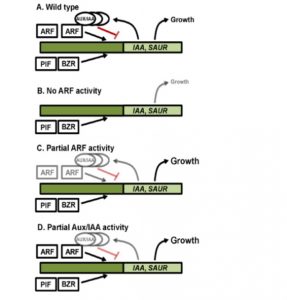 By now we’re probably all familiar with the central dogma of auxin signalling; that the interaction between auxin and auxin receptors (e.g., TIR1) leads to degradation of Aux/IAA proteins, freeing up ARF transcription factors to do their things. The complexity of this simple system arises in part due to the large numbers of all of the constituent parts. Reed et al. have used a genetic approach to tease apart the roles of several ARFs in the hypocotyl elongation response. They generated multi-mutations in several ARFs, and combined these with microRNA constructs that specifically silence various ARFs. Hypocotyls became progressively shorter as additional ARF genes were knocked out, demonstrating overlapping functions for the ARFs. Furthermore, the mutants primarily affected hypocotyl elongation in conditions in which auxin promotes rapid elongation e.g., response to darkness, far-red light or high temperatures. The knock-out lines showed some but reduced responses to gibberellins and brassinosteroids, suggesting that these other growth-promoting hormones can compensate to some extent for the loss of auxin response. (Summary by Mary Williams) Plant Physiol. 10.1104/pp.18.00718
By now we’re probably all familiar with the central dogma of auxin signalling; that the interaction between auxin and auxin receptors (e.g., TIR1) leads to degradation of Aux/IAA proteins, freeing up ARF transcription factors to do their things. The complexity of this simple system arises in part due to the large numbers of all of the constituent parts. Reed et al. have used a genetic approach to tease apart the roles of several ARFs in the hypocotyl elongation response. They generated multi-mutations in several ARFs, and combined these with microRNA constructs that specifically silence various ARFs. Hypocotyls became progressively shorter as additional ARF genes were knocked out, demonstrating overlapping functions for the ARFs. Furthermore, the mutants primarily affected hypocotyl elongation in conditions in which auxin promotes rapid elongation e.g., response to darkness, far-red light or high temperatures. The knock-out lines showed some but reduced responses to gibberellins and brassinosteroids, suggesting that these other growth-promoting hormones can compensate to some extent for the loss of auxin response. (Summary by Mary Williams) Plant Physiol. 10.1104/pp.18.00718
Circadian oscillations of cytosolic free calcium regulate the Arabidopsis circadian clock
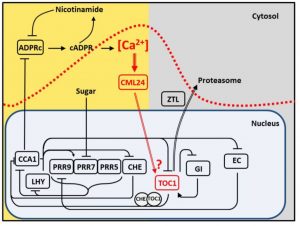 The circadian rhythm confers competitive advantages by coordinating the physiology and behavior of biological systems. The internal clock in eukaryote organisms comprises feedback loops, and in Arabidopsis most of them involve negative transcriptional regulation events as well as post-transciptional, post-translational and metabolic regulation. In this paper, Martí Ruiz et al. show a direct association between the oscillations of cytosolic free Ca2+ and the circadian rhythms. They demonstrate that the expression levels of CCA1 HIKING EXPEDITION (CHE), a repressor of the clock core gene CIRCADIAN CLOCK ASSOCIATED1 (CCA1), is negatively correlated with Ca2+ oscillations. Further, they were able to link the Ca2+ oscillations to the circadian period regulation by studying mutants of the Ca2+ sensor calmodulin-like 24 (CML24). They found that mutations in CLM24 are epistatic to mutations in the clock gene TIMING OF CAB2 EXPRESSION1 (TOC1), and therefore these genes could be involved in the same circadian period regulation pathway. (Summary by Aime Jaskolowski) Nature Plants 10.1038/s41477-018-0224-8
The circadian rhythm confers competitive advantages by coordinating the physiology and behavior of biological systems. The internal clock in eukaryote organisms comprises feedback loops, and in Arabidopsis most of them involve negative transcriptional regulation events as well as post-transciptional, post-translational and metabolic regulation. In this paper, Martí Ruiz et al. show a direct association between the oscillations of cytosolic free Ca2+ and the circadian rhythms. They demonstrate that the expression levels of CCA1 HIKING EXPEDITION (CHE), a repressor of the clock core gene CIRCADIAN CLOCK ASSOCIATED1 (CCA1), is negatively correlated with Ca2+ oscillations. Further, they were able to link the Ca2+ oscillations to the circadian period regulation by studying mutants of the Ca2+ sensor calmodulin-like 24 (CML24). They found that mutations in CLM24 are epistatic to mutations in the clock gene TIMING OF CAB2 EXPRESSION1 (TOC1), and therefore these genes could be involved in the same circadian period regulation pathway. (Summary by Aime Jaskolowski) Nature Plants 10.1038/s41477-018-0224-8
Membrane anchored LTPs participate in preinvasive defense against powdery mildew pathogens
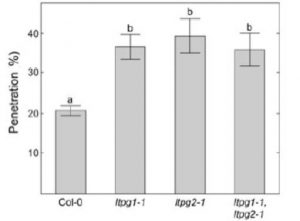 Plant lipid transfer proteins (LTPs) display a strikingly clear capacity to bind lipidic molecules yet their mechanistic role in plant developmental or stress physiology is not yet clear. In a recent study published in Molecular Plant Pathology, Fahlberg et al. (2018) investigated the role of glycophosphatidylinositiol-(GPI)-anchored LTPs in resistance to non-adapted powdery mildew pathogens in Arabidopsis. The authors found that the loss of several LTPGs (LTPG1, 2, 5, or 6) led to enhanced susceptibility to the grass powdery mildew pathogen Blumeria graminis sp. hordei. Enhanced susceptibility in these mutants was associated with increased prevalence of fungal penetration of the epidermal cell wall, suggesting that LTPGs play a key role in pre-invasive defense against filamentous pathogens. This idea was further supported by protein localization studies demonstrating that LTPG1 accumulates at Bgh penetration sites where plants actively deposit cell wall materials in an effort to suppress pathogen invasion. Together, these data demonstrate that LTPGs contribute to non-host resistance to filamentous pathogens. (Summary by Phil Carella) Mol. Plant Pathol. 10.1111/mpp.12740
Plant lipid transfer proteins (LTPs) display a strikingly clear capacity to bind lipidic molecules yet their mechanistic role in plant developmental or stress physiology is not yet clear. In a recent study published in Molecular Plant Pathology, Fahlberg et al. (2018) investigated the role of glycophosphatidylinositiol-(GPI)-anchored LTPs in resistance to non-adapted powdery mildew pathogens in Arabidopsis. The authors found that the loss of several LTPGs (LTPG1, 2, 5, or 6) led to enhanced susceptibility to the grass powdery mildew pathogen Blumeria graminis sp. hordei. Enhanced susceptibility in these mutants was associated with increased prevalence of fungal penetration of the epidermal cell wall, suggesting that LTPGs play a key role in pre-invasive defense against filamentous pathogens. This idea was further supported by protein localization studies demonstrating that LTPG1 accumulates at Bgh penetration sites where plants actively deposit cell wall materials in an effort to suppress pathogen invasion. Together, these data demonstrate that LTPGs contribute to non-host resistance to filamentous pathogens. (Summary by Phil Carella) Mol. Plant Pathol. 10.1111/mpp.12740
Increase in crop losses to insect pests in a warming climate ($)
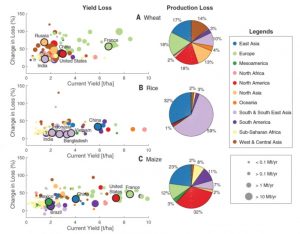 Much has been discussed about the impacts of abiotic effects (e.g., heat and drought stress) on crop yields arising from climate change. Here, Deutsch and Tewksbury et al. evaluate how a changing climate will affect crop (wheat, rice and maize) yields through increases in insect herbivory. Temperature affects herbivorous insects in two ways. First, with rising temperatures, their metabolism (and food consumption rate) rises, and second, it can affect their rate of population growth. This latter effect is spatially more variable, as in some regions the temperature is optimal for insect lifecycle, and further temperature increases are likely to lead to a decrease in insect populations. The authors consider both of these factors at various temperature anomalies. The negative impact of insect herbivory is going to be particularly detrimental to wheat, which is grown in temperate regions. The authors summarize: “Without wider attention to how climate warming will affect crop breeding and sustainable pest management strategies, insect driven yield losses will result in reduced global grain supplies and higher staple food prices. Poor grain consumers and farming households, who account for a large share of the world’s 800 million people living in chronic hunger, will suffer most.” (Summary by Mary Williams) Science 10.1126/science.aat3466
Much has been discussed about the impacts of abiotic effects (e.g., heat and drought stress) on crop yields arising from climate change. Here, Deutsch and Tewksbury et al. evaluate how a changing climate will affect crop (wheat, rice and maize) yields through increases in insect herbivory. Temperature affects herbivorous insects in two ways. First, with rising temperatures, their metabolism (and food consumption rate) rises, and second, it can affect their rate of population growth. This latter effect is spatially more variable, as in some regions the temperature is optimal for insect lifecycle, and further temperature increases are likely to lead to a decrease in insect populations. The authors consider both of these factors at various temperature anomalies. The negative impact of insect herbivory is going to be particularly detrimental to wheat, which is grown in temperate regions. The authors summarize: “Without wider attention to how climate warming will affect crop breeding and sustainable pest management strategies, insect driven yield losses will result in reduced global grain supplies and higher staple food prices. Poor grain consumers and farming households, who account for a large share of the world’s 800 million people living in chronic hunger, will suffer most.” (Summary by Mary Williams) Science 10.1126/science.aat3466



